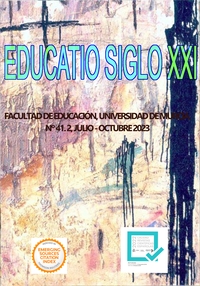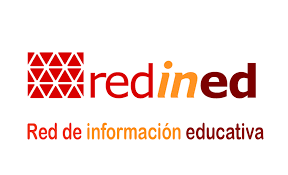Analysis of the permanent training of university lecturers through photographs taken by their students
Abstract
This study explores whether university teaching can improve through the photographic materialization of students' perceptions during teaching situations. More specifically, we tapped into whether these photographs could help teachers evoke the content of their experiential images, thus generating doubts that led to any change in their teaching. The experiential, intimate and tacit nature of the data required an interpretative design based on a multiple case study. Data collection was done through photographs and photo-elicitation processes. The results obtained in a focus group, which were coded, showed that the students participated to assess the methodology followed in the subjects. Although their level of photographic literacy was different, they used large shots to show human interactions, and detail shots to focus on relevant elements. Following students’ assessment of lecturers’ work, the latter introduced some changes in their practice, especially for those aspects in which there was a discrepancy between their experiential perception and students’ perceptions. The low rate of change advises a review of the photo-elicitation procedure followed so that more dilemmas in relation to lecturers’ teaching practice can be brought up, thus inducing greater possibilities for change.
Downloads
-
Abstract632
-
PDF (Español (España))357
References
Alonso, I., Gezuraga, M., Berasategi, M. & Legorburu, I. (2019). La identidad académica del profesorado de aprendizaje-servicio. Una manera transformadora de ser y estar en la universidad. Bordón, 71(3), 133-150. http://doi. org/10.13042/Bordon.2019.68435.
Barbour, R., & Morgan, D. L. (Eds.). (2017). A new era in focus groups: Challenges, innovations and practice. Palgrave MacMillan.
Barthes, R. (1994). El susurro del lenguaje. Paidós.
Bautista, A.; Rayón, L., & de las Heras, A. M. (2018). Imágenes experienciales y foto-elicitación en la formación del profesorado. Educatio Siglo XXI, 36(2 Jul-Oct), 135–162. https://doi.org/10.6018/j/333001
Brandt, J., Bürgener, L., Barth, M., & Redman, A. (2019). Becoming a competent teacher in education for sustainable development: learning outcomes and processes in teacher education. International Journal of Sustainability in Higher Education, 20 (4), 630-653. http://doi. org/10.1108/IJSHE-10-2018-0183
Becke, S. D., & Bongard, S. (2018). Using photo elicitation to introduce a network perspective on attachment during middle childhood. International Journal of Qualitative Methods, 17, 1-12. http://doi. org/10.1177/1609406918797017
Behari-Leak, K. (2017). New academics, new higher education contexts: A critical perspective on professional development. Teaching in Higher Education, 22(5), 485-500.
Clark, A., & Morris, L. (2017). The use of visual methodologies in social work research over the last decade: A narrative review and some questions for the future. Qualitative Social Work, 16(1), 29-43. http://doi. org/10.1177/1473325015601205
Coles-Ritchie, M., Monson, B., & Moses, C. (2015). Drawing on dynamic local knowledge through student-generated photography. Equity & Excellence in Education, 48(2), 266-282. http://doi. org/10.1080/10665684.2015.1025615
Collier, J. (1954). Photography in Anthropology: A Report on Two Experiments. American Anthropologist, 59(5), 843–859. https://doi.org/10.1525/aa.1957.59.5.02a00100
Cotán, A. (2019). Investigación narrativa para contar historias: líneas de vida de estudiantes universitarios con discapacidad. Revista de la Educación Superior, 48(192), 23-47.
Charmaz, K. (2006). Constructing Grounded Theory: A Practical Guide Through Qualitative Analysis. Sage.
Day, C. (2014). Pasión por enseñar. La identidad personal y profesional del docente y sus valores. Narcea.
Fanning, S. (2011, June 20-21) Visual methodologies: Photo-Elicitation in the university classroom. In M. Ashwin (Ed.), Proceedings of the 10th European Conference on Research Methodology for Business and Management Studies (pp. 180-188). Normandy Business School.
Gibbs, G. (2012). El análisis de datos cualitativos en investigación cualitativa. Morata.
Glaw, X., Inder, K., Kable, A., & Hazelton, M. (2017). Visual Methodologies in Qualitative Research: Autophotography and Photo Elicitation Applied to Mental Health Research. International Journal of Qualitative Methods, 16(1), 1–8. https://doi.org/10.1177/1609406917748215
Golombek, P. R., & Johnson, K. E. (2017). Re-conceptualizing teachers’ narrative inquiry as professional development. PROFILE: Issues in Teachers’ Professional Development, 19(2), 15-28. http://doi.org/10.15446/profile.v19n2.65692
Grimmet, K. (2018). Using photo-elicitation to break the silence. In: M.L. Boucher (Ed.), Participant Empowerment Through Photo-elicitation in Ethnographic Education Research. New Perspectives and Approaches (pp. 71-92). Springer.
Hevia, I.; Fueyo, A. & Belver, J. (2019). La Lesson Study. Una metodología para reconstruir el conocimiento docente universitario. Revista Complutense de Educación, 30(4), 1067-1081. https://doi.org/10.5209/rced.60076
Joy, P., & Numer, M. (2017). The use of photo elicitation to explore the benefits of queer student advocacy groups in university. Journal of Lgbt Youth, 14(1), 31-50. http://doi.org/10.1080/19361653.2016.1256247
Kearns, S. (2012). Seeking researcher identity through the co-construction and representation of young people’s narratives of identity. Educational Action Research, 20(1), 23–40. https://doi.org/10.1080/09650792.2012.647637
Legge, M., & Smith, W. (2014). Teacher education and experiential learning: A visual ethnography. Australian Journal of Teacher Education, 39(12), 94-109. http://doi.org/10.14221/ ajte.2014v39n12.7
Madden, L.T., & Smith, A. D. (2015). Using photographs to integrate liberal arts learning in business education. Journal of Management Education, 39(1), 116-140. http://doi.org/10.1177/1052562913512487
Marín, D., Pardo, M. I., Vidal, M., & San Martín, Á. (2021). Indagación narrativa y construcción de identidades docentes: la reflexión pedagógica como herramienta de formación docente. Revista Electrónica Interuniversitaria de Formación del Profesorado, 24(2). https://doi.org/10.6018/reifop.469691
Medinabeitia, A., & Fernández, I. (2017). El desarrollo docente del profesorado universitario: análisis y sistematización del concepto. Teoría de la Educación, 29(2), 87-108. http://doi.org/10.14201/teoredu29287108
Minthorn, R. S., & Marsh, T. E. J. (2016). Centering indigenous college student voices and perspectives through photovoice and photo-elicitation. Contemporary Educational Psychology, 47, 4-10. http://doi.org/10.1016/j.cedpsych.2016.04.010
Ndione, L. C., & Remi, C. (2018). Combining images and words in order to understand the cultural meaning of practices: what photo-elicitation reveals. Recherche et Applications in Marketing, (0), 1-24. http://doi.org/10.1177/2051570718782450
Panofsky, E. (1972). El significado de las artes visuales. Alianza.
Ramos, S. L., & Feria, Y. (2016). La noción de sentido de lugar: Una aproximación por medio de textos narrativos y fotografías. Innovación Educativa, 16(71), 83-110.
Raven, N. (2015). New perspectives using participatory photography to evaluate widening participation interventions. Research in Post-Compulsory Education, 20(4), 460-475. http://doi.org/10.1080/13596748.2015.1081750
Richard, V. M., & Lahman, M. K. E. (2015). Photo-elicitation: Reflexivity on method, analysis, and graphic portraits. International Journal of Research & Method in Education, 38(1), 3–22. Doi: https://doi.org/10.1080/1743727X.2013.843073
Said, A. (2018). Vocational Teaching-Learning through the Eyes of Undergraduate Vocational Students in Malta: A Qualitative Exploratory Study. International Journal for Research in Vocational Education and Training, 5(1), 42-63. http://doi.org/10.13152/IJRVET.5.1.3
Schreier, M. (2014). Qualitative content analysis. In U. Flick (Ed.). The SAGE Handbook of Qualitative Data Analysis (pp. 49-63). Sage.
Seow, T. (2016). Reconciling discourse about geography and teaching geography: The case of Singapore pre-service teacher. International Research in Geographical and Environmental Education, 25(2) 151-165. http://doi.org/10.1080/10382046.2016.1149342
Stake, R.E. (2000). Case studies. In N. K. Denzin & Y. S. Lincoln (Eds.), Handbook of qualitative research (pp. 435-454). Sage.
Stockall, N. & Davis, S. (2011). Uncovering pre-service teacher beliefs about Young children: A photographic elicitation methodology. Issues in Educational Research, 21(2), 192-209.
Vygotski, L. S. (1979). El desarrollo de los procesos mentales superiores. Crítica.
Walls, J., & Holquist, S. E. (2019). Through their eyes, in their words: using photo-elicitation to amplify student voice in policy and school improvement research. In K. Strunk & L. Locke (Eds.), Research Methods for Social Justice and Equity in Education (pp. 151-161). Palgrave Macmillan.
Wang, C. C. (2006). Youth participation on photovoice as a strategy for community change. Journal of Community Practice, 14(1-2), 147-161. http://doi.org/10.1300 / J125v14n01_09
Watt, S. & Wakefield, C. (2014). Picture it! The use of visual methods in psychology teaching. Psychology Teaching Review, 20(1), 68-77.
Yslado, R. M. ., Ramirez, E. H., García-Figueroa, M. E., & Arquero, J. L. (2021). Clima laboral y burnout en profesores universitarios. Revista Electrónica Interuniversitaria de Formación del Profesorado, 24(3). https://doi.org/10.6018/reifop.476651
Zecevic, A., Magalhaes, L., Madady, M., Halligan, M. & Reeves, A. (2010). Happy and healthy only if occupied? Perception of health sciences students on occupation in later life. Australian Occupational Therapy Journal, 57(1), 17-23. http://doi.org/10.1111/j.1440-1630.2009.00841.x
Copyright (c) 2023 Servicio de Publicaciones de la Universidad de Murcia

This work is licensed under a Creative Commons Attribution-NonCommercial-NoDerivatives 4.0 International License.
Original work publishes in this journal is subject to the following terms:
1. Murcia University Press (the publishing house) holds the copyright of the publishes work, and favours and allows their reutilization under the use license stated in point 2.
© Servicio de Publicaciones, Universidad de Murcia, 2015
2. Work is published in the electronic edition under a license (Creative Commons Reconocimiento-NoComercial-SinObraDerivada 4.0 España (legal text). They can be copied, used, disseminated, transmitted and publicly presented, as long as: i) authorship and original publication source is acknowledged (journal, publishing house and URL of the work); ii) are not used for commercial purposes; iii) the existence and specifications of this use license is stated.
3. Conditions for self-archive. Authors are allowed and encouraged to disseminate electronically the pre-pint (before review) and/or post-print (accepted for publication) versions of their work before their publication since that favours earlier circulation and dissemination resulting in an increased chance for the authors to be cited and for the work to reach a bigger share of the academic community. Colour: RoMEO: green.







